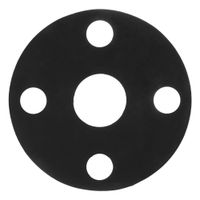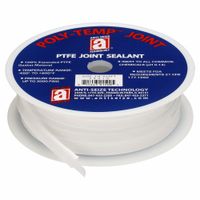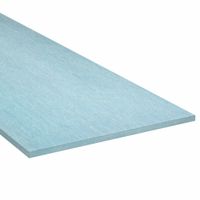Call +(254) 703 030 000 / 751 483 999 / 721 704 777
- Home
- Pipe Hose Tube Fittings
- Pipe Pipe Fittings
- Pipe Fitting Gaskets
.....Read More
Frequently Asked Questions
What are the different types of pipe fitting gaskets?
Pipe fitting gaskets are essential components used to create a seal between two surfaces in piping systems, preventing leaks. The different types of pipe fitting gaskets include:
1. **Ring Gaskets**: These are circular gaskets used primarily in flanged connections. They fit into a groove on the flange face and are commonly used in high-pressure applications.
2. **Full-Face Gaskets**: These cover the entire face of the flange and have bolt holes to align with the flange bolts. They are used in low-pressure applications and provide a larger sealing area.
3. **Spiral Wound Gaskets**: Made from a combination of metal and filler material, these gaskets are suitable for high-pressure and high-temperature applications. They are versatile and can accommodate flange surface irregularities.
4. **Metal Jacketed Gaskets**: These consist of a soft filler material encased in a metal jacket. They are used in high-temperature and high-pressure environments, providing durability and strength.
5. **Non-Asbestos Gaskets**: Made from synthetic fibers and fillers, these gaskets are used as an alternative to asbestos gaskets. They are suitable for a wide range of temperatures and pressures.
6. **Rubber Gaskets**: Made from materials like EPDM, Nitrile, or Neoprene, these gaskets are used in low-pressure applications and provide excellent flexibility and sealing properties.
7. **PTFE Gaskets**: Known for their chemical resistance, PTFE gaskets are used in applications involving aggressive chemicals and high temperatures.
8. **Kammprofile Gaskets**: These have a metal core with a serrated profile and a soft sealing layer. They are used in high-pressure and high-temperature applications, providing excellent sealing performance.
9. **Corrugated Metal Gaskets**: These gaskets have a corrugated metal core with a soft facing material. They are used in applications requiring high compressibility and recovery.
Each type of gasket is selected based on the specific requirements of the application, including pressure, temperature, and chemical compatibility.
How do you choose the right gasket material for a specific application?
To choose the right gasket material for a specific application, consider the following factors:
1. **Temperature**: Determine the operating temperature range. Materials like graphite and PTFE are suitable for high temperatures, while rubber is better for lower temperatures.
2. **Pressure**: Assess the pressure conditions. Metal gaskets are ideal for high-pressure environments, whereas rubber or non-metallic gaskets work well for lower pressures.
3. **Chemical Compatibility**: Identify the chemicals the gasket will contact. PTFE and Viton offer excellent chemical resistance, while natural rubber may degrade with certain chemicals.
4. **Media**: Consider the type of media (liquid, gas, or solid) the gasket will seal. This affects material choice due to potential swelling or degradation.
5. **Environmental Conditions**: Evaluate exposure to UV, ozone, or weathering. EPDM and silicone are resistant to environmental factors, while some materials may deteriorate.
6. **Mechanical Properties**: Consider the need for flexibility, compressibility, and recovery. Rubber offers good flexibility, while metal provides strength and durability.
7. **Regulatory Requirements**: Ensure compliance with industry standards and regulations, such as FDA, NSF, or API, which may dictate material choices.
8. **Cost**: Balance performance with budget constraints. Some high-performance materials may be costly but necessary for critical applications.
9. **Installation and Maintenance**: Consider ease of installation and maintenance. Some materials require specific handling or tools.
10. **Longevity and Reliability**: Evaluate the expected lifespan and reliability. High-quality materials may offer longer service life, reducing downtime and maintenance costs.
By systematically analyzing these factors, you can select a gasket material that ensures optimal performance, safety, and cost-effectiveness for your specific application.
What is the difference between a flange gasket and a regular gasket?
A flange gasket is specifically designed for use in flanged connections, which are common in piping systems. These gaskets are tailored to fit between two flanges to create a seal that prevents leaks of fluids or gases. Flange gaskets are typically circular and come in various types, such as ring gaskets, full-face gaskets, and spiral wound gaskets, each suited for different pressure and temperature conditions.
On the other hand, a regular gasket is a broader term that refers to any sealing material used to fill the space between two or more mating surfaces to prevent leakage. Regular gaskets can be used in a wide range of applications beyond flanged connections, such as in engines, pumps, and machinery. They can be made from various materials, including rubber, silicone, metal, cork, and paper, depending on the specific requirements of the application.
The primary difference lies in their application and design specificity. Flange gaskets are specifically engineered for flanged joints, ensuring a precise fit and optimal sealing performance in these settings. Regular gaskets, however, are more versatile and can be used in a variety of sealing applications, not limited to flanges. Additionally, flange gaskets often need to withstand higher pressures and temperatures, requiring more robust materials and designs compared to some regular gaskets used in less demanding environments.
How do you properly install a pipe fitting gasket?
To properly install a pipe fitting gasket, follow these steps:
1. **Select the Right Gasket**: Ensure the gasket material is compatible with the fluid, temperature, and pressure of the system. Check the size and type to match the flange and pipe specifications.
2. **Inspect Flanges and Gasket**: Examine the flange faces for any damage, corrosion, or debris. Ensure the gasket is free from defects and is the correct size and type.
3. **Clean Surfaces**: Thoroughly clean the flange faces and the gasket. Remove any dirt, oil, or old gasket material to ensure a proper seal.
4. **Align Flanges**: Ensure the flanges are properly aligned. Misalignment can cause uneven pressure on the gasket, leading to leaks.
5. **Insert Gasket**: Place the gasket between the flanges. Ensure it is centered and not protruding into the pipe bore.
6. **Lubricate Bolts**: Apply a suitable lubricant to the bolt threads and nut faces to reduce friction and achieve uniform bolt tension.
7. **Tighten Bolts**: Use a torque wrench to tighten the bolts in a crisscross pattern. This ensures even pressure distribution across the gasket. Follow the manufacturer's recommended torque specifications.
8. **Re-Torque**: After initial tightening, allow the gasket to settle, then re-torque the bolts to the specified torque. This compensates for any relaxation in the gasket material.
9. **Inspect for Leaks**: Once installed, inspect the joint for leaks. If necessary, tighten bolts further, but do not exceed the maximum torque specification.
10. **Regular Maintenance**: Periodically check the gasket and flange for signs of wear or leaks, and replace the gasket as needed to maintain a proper seal.
What are common causes of gasket failure in piping systems?
Common causes of gasket failure in piping systems include:
1. **Improper Installation**: Incorrect alignment, uneven bolt tightening, or using the wrong gasket size can lead to leaks and failure.
2. **Material Incompatibility**: Using a gasket material that is not compatible with the fluid or the temperature and pressure conditions can cause degradation and failure.
3. **Excessive Compression**: Over-tightening bolts can crush the gasket, reducing its ability to seal effectively.
4. **Insufficient Compression**: Under-tightening can lead to inadequate sealing pressure, allowing leaks to occur.
5. **Thermal Cycling**: Repeated heating and cooling can cause expansion and contraction, leading to gasket fatigue and failure.
6. **Chemical Attack**: Exposure to aggressive chemicals can degrade gasket materials, leading to loss of integrity.
7. **Aging and Wear**: Over time, gaskets can become brittle or lose elasticity, especially if exposed to harsh conditions.
8. **Mechanical Damage**: Physical damage during installation or maintenance can compromise the gasket's sealing ability.
9. **Flange Surface Condition**: Irregularities or damage on the flange surface can prevent proper sealing.
10. **Vibration**: Continuous vibration can cause loosening of bolts and degradation of the gasket material.
11. **Pressure Variations**: Fluctuations in pressure can stress the gasket, leading to failure.
12. **Improper Storage**: Exposure to sunlight, moisture, or extreme temperatures during storage can degrade gasket materials before installation.
13. **Design Flaws**: Inadequate design of the gasket or flange system can lead to uneven stress distribution and failure.
14. **Environmental Factors**: External conditions such as UV exposure, ozone, or extreme temperatures can affect gasket performance.
Addressing these issues through proper selection, installation, and maintenance can help prevent gasket failure in piping systems.
How do you measure for a replacement gasket?
To measure for a replacement gasket, follow these steps:
1. **Remove the Old Gasket**: Carefully remove the existing gasket from its position without damaging it, as it will serve as a reference.
2. **Measure the Outer Diameter (OD)**: Lay the gasket flat and use a ruler or caliper to measure the outer diameter from edge to edge across the center.
3. **Measure the Inner Diameter (ID)**: Measure the inner diameter by placing the ruler or caliper across the center of the inner opening.
4. **Measure the Thickness**: Use a caliper to measure the thickness of the gasket. If a caliper is unavailable, use a micrometer for more precision.
5. **Measure the Width**: If the gasket is a ring type, measure the width of the gasket material from the inner edge to the outer edge.
6. **Note the Material**: Identify the material of the old gasket (e.g., rubber, cork, metal) to ensure compatibility with the application.
7. **Check for Special Features**: Look for any special features such as grooves, ridges, or holes that need to be replicated in the replacement gasket.
8. **Consider the Environment**: Take note of the operating environment, including temperature, pressure, and exposure to chemicals, to select a suitable material for the replacement.
9. **Consult Manufacturer Specifications**: If available, refer to the equipment’s manual or manufacturer specifications for recommended gasket dimensions and materials.
10. **Order the Replacement**: With all measurements and material specifications in hand, order the replacement gasket from a reliable supplier, ensuring it matches the required dimensions and material properties.
By following these steps, you can accurately measure and select a replacement gasket that fits and functions correctly in its intended application.
What maintenance is required for gaskets in piping systems?
Maintenance of gaskets in piping systems involves several key steps to ensure their longevity and effectiveness:
1. **Regular Inspection**: Conduct routine inspections to check for signs of wear, damage, or leaks. Look for any deformation, cracks, or chemical degradation.
2. **Cleaning**: Ensure that the flange surfaces and gaskets are clean before installation. Remove any debris, rust, or old gasket material to prevent improper sealing.
3. **Proper Installation**: Use the correct torque specifications during installation to avoid over-compression or under-compression, which can lead to leaks or gasket failure.
4. **Material Compatibility**: Ensure that the gasket material is compatible with the fluid being transported and the operating temperature and pressure conditions.
5. **Replacement**: Replace gaskets at regular intervals or when they show signs of deterioration. Do not reuse gaskets as they may not seal properly after being compressed.
6. **Storage**: Store gaskets in a cool, dry place away from direct sunlight and chemicals to prevent premature aging or damage.
7. **Documentation**: Keep records of gasket specifications, installation dates, and maintenance activities to track performance and schedule timely replacements.
8. **Training**: Ensure that personnel involved in gasket installation and maintenance are properly trained to handle and install gaskets correctly.
9. **Leak Detection**: Use leak detection methods such as pressure testing or ultrasonic testing to identify potential leaks early.
10. **Environmental Considerations**: Consider environmental factors such as temperature fluctuations and chemical exposure that may affect gasket performance and adjust maintenance schedules accordingly.
By following these maintenance practices, the integrity and reliability of gaskets in piping systems can be maintained, reducing the risk of leaks and system failures.



